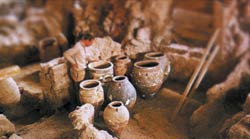|
« previous 25 of 38 next » | |||
In fact, the explosion was so massive that the mountain blew out its core and collapsed into itself forming a large hole called a “caldera”. Only a portion of the original Island of Santorini remains: the upper edges of the caldera. The ocean has filled in the collapsed part of the caldera. More volcanic activity over the years has produced a new volcano in the caldera. Amazingly, however, no human remains were found in excavations of the nearest city which had also been covered in volcanic ash, in the same way as Pompeii. It is believed that the residents saw the warning signs and left the area. No objects of value were ever found either. It is thought that people left with enough time to take their belongings with them. Even though this eruption took place 1,562 years before the one in Pompeii, the people seemed to know they needed to leave. They were on an island, and, maybe with hints from the Earth below, they felt they would be safer on the mainland. What warnings did the people on Santorini have? First, there was a significant earthquake several years before the major volcanic explosion. Then there were lighter eruptions before the main eruption. There is evidence that the citizens of Santorini rebuilt in the same place after the earthquake, which is the same as what the citizens of Pompeii did after the earthquake of 62 A.D. We know that the Earthquake wasn’t enough to convince the people to move away from the volcano. |
|||
